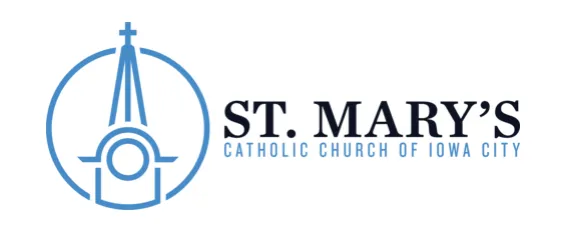
The Sacred Statuary of St. Mary of the Visitation
IOWA CITY, IOWA
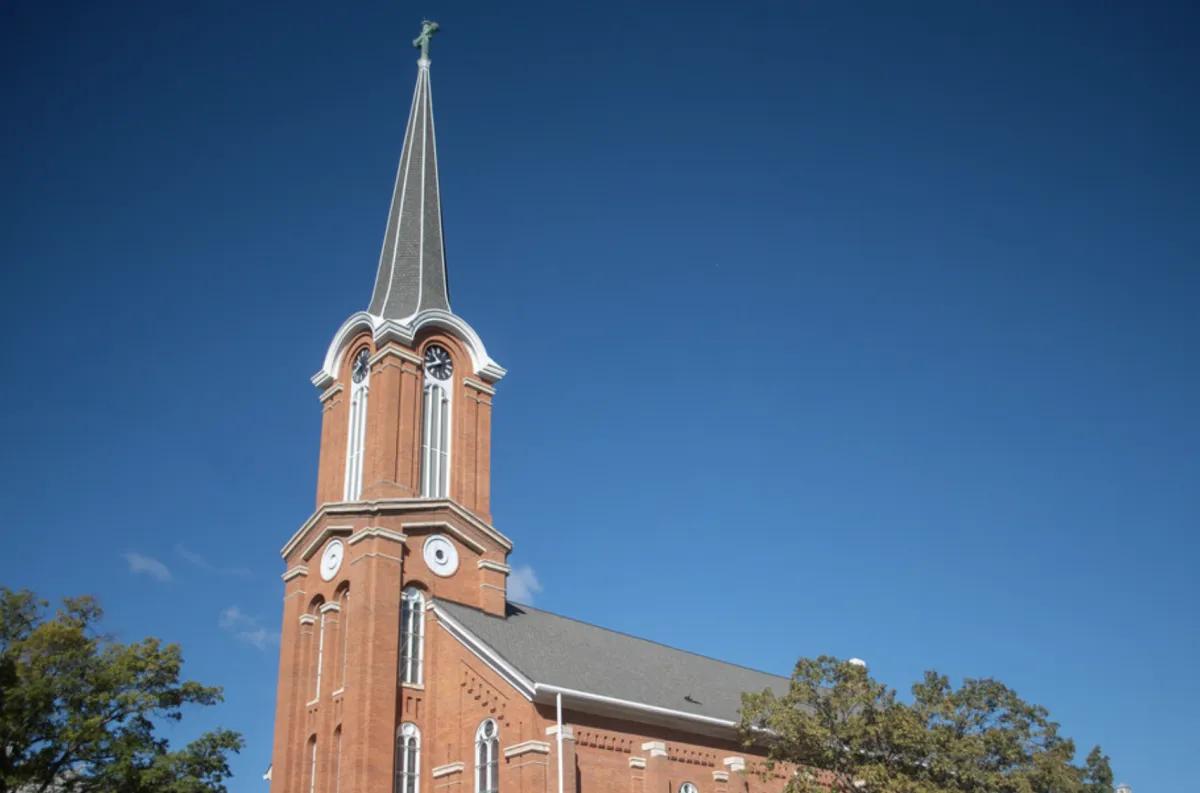
Welcome to St. Mary of the Visitation
Nestled in the heart of Iowa City, St. Mary of the Visitation welcomes all who enter with a profound sense of sacred beauty and spiritual reflection. Among its many treasures, the parish is adorned with carefully placed statues—each one a silent witness to our Catholic faith, rich in symbolism, history, and devotion.
These sacred images are not merely decorations; they are visual prayers, reminders of the communion of saints, and gentle guides pointing our hearts toward heaven.
This guide invites you to explore the deeper meaning behind each statue within our parish. Whether you are a lifelong parishioner or a first-time visitor, may your journey through this sacred statuary renew your sense of wonder, deepen your understanding of the saints, and draw you ever closer to Christ through their holy example.
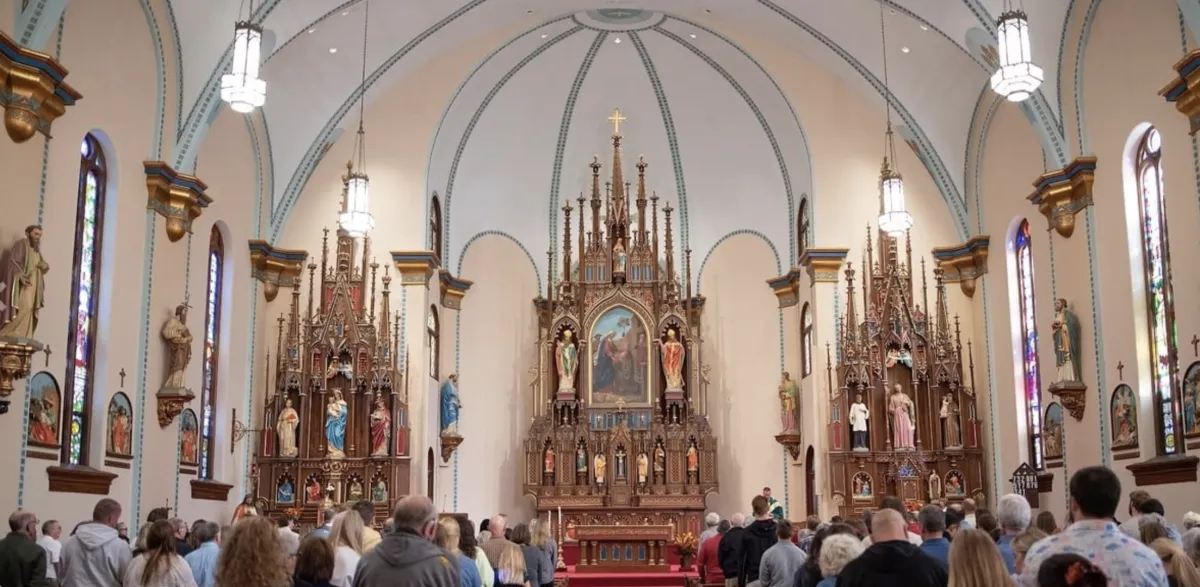
The High Altar
Located in the Center of the Parish
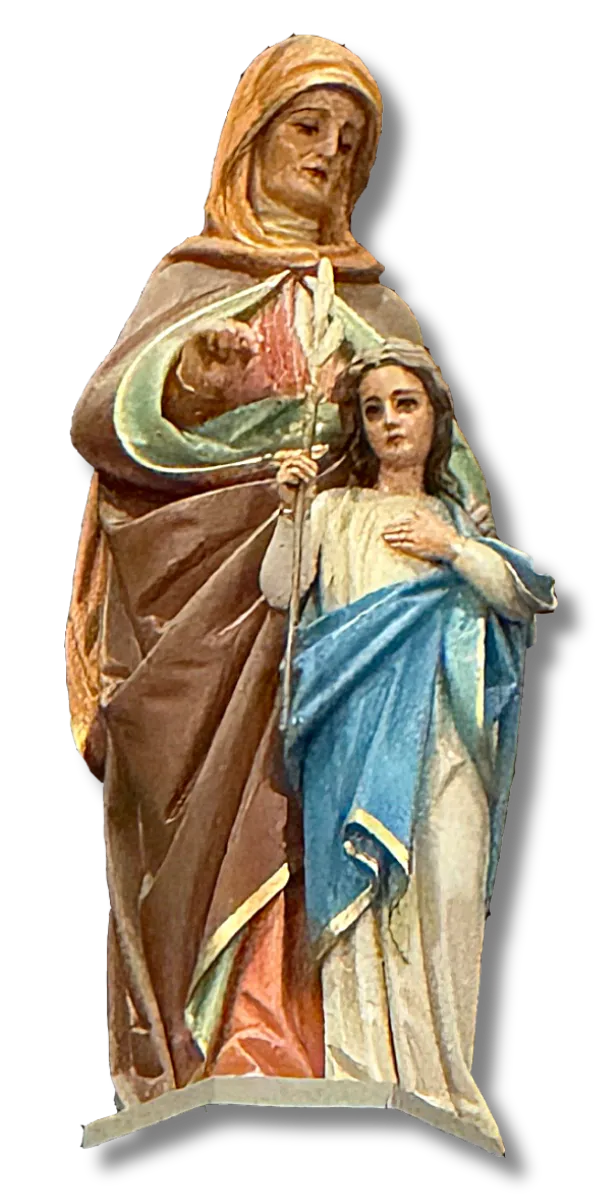
Mary and the Adolescent Christ: A Moment of Grace and Growth
At the summit of the High Altar of St. Mary of the Visitation, this elegant statue captures a rare and deeply meaningful moment: the Blessed Virgin Mary alongside a teenage Jesus, depicted not as an infant nor yet as the crucified Savior, but as a youth on the threshold of His public mission. Standing beside His mother, Jesus holds a slender staff topped with a blooming lily—a powerful symbol of purity, divine calling, and spiritual authority.
Mary, robed in her traditional blue and white garments, stands in calm, maternal presence—her gaze gentle, serene, and filled with contemplative love. She is both mother and first disciple, watching her Son grow in wisdom and stature, even as the mystery of His mission unfolds.
The blooming lily in Jesus' hand signifies not only His sinless purity, but also reflects a motif traditionally associated with St. Joseph, connecting the image to the holy family’s hidden years and Jesus’ formation in faith, obedience, and work. His youthful posture—confident yet humble—invites the faithful to reflect on the sacredness of daily life, spiritual growth, and the unfolding of divine purpose over time.
This statue draws the eyes upward, lifting hearts to the mystery of Christ’s humanity and divinity, and honoring Mary’s enduring presence in every stage of His earthly life.
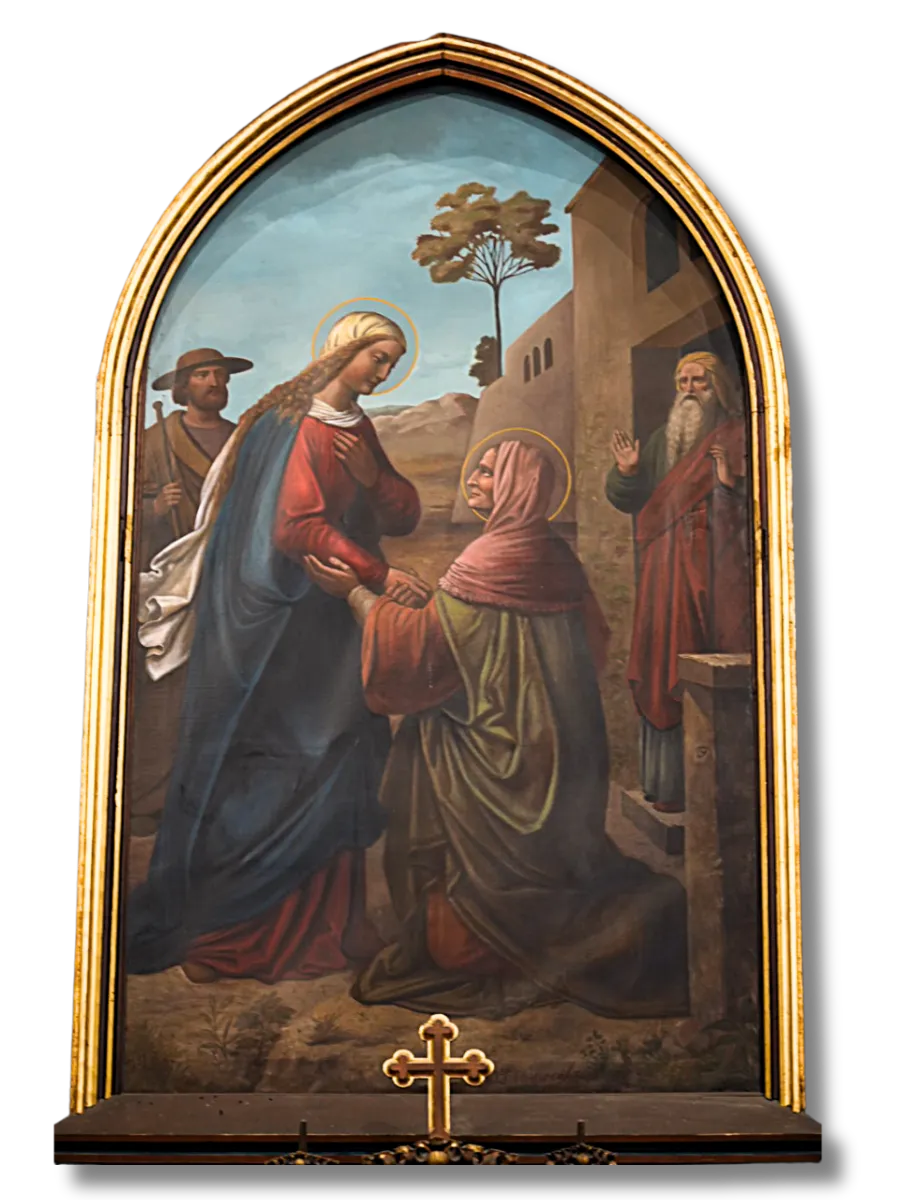
The Visitation: A Meeting of Grace and Joy
Crowning the High Altar of St. Mary of the Visitation is a radiant painting that captures one of the most tender and spiritually profound moments in salvation history: the Visitation. In this sacred scene, the Blessed Virgin Mary, newly overshadowed by the Holy Spirit and bearing within her the Son of God, arrives at the home of her kinswoman Elizabeth, who herself carries the future prophet, John the Baptist.
The two women meet in a moment of shared wonder—Mary, the young and humble servant of the Lord, and Elizabeth, filled with the Holy Spirit, greeting her with the immortal words, “Blessed are you among women, and blessed is the fruit of your womb” (Luke 1:42). Their embrace, depicted with grace and warmth, reflects the mystery of divine life stirring within both of them, and the joy that overflows when faith encounters faith.
Set against a soft and heavenly backdrop, the painting radiates the themes of humility, obedience, and joyful expectation. It reminds the faithful that God's presence often enters the world not through thunder and spectacle, but through quiet acts of love, service, and trust.
Fittingly placed at the summit of the High Altar, this image draws every eye upward, inviting worshippers to contemplate the mystery of the Incarnation and the profound beauty of a soul that says “yes” to God. It is a visual hymn of praise, echoing the words of Mary herself: “My soul magnifies the Lord.”
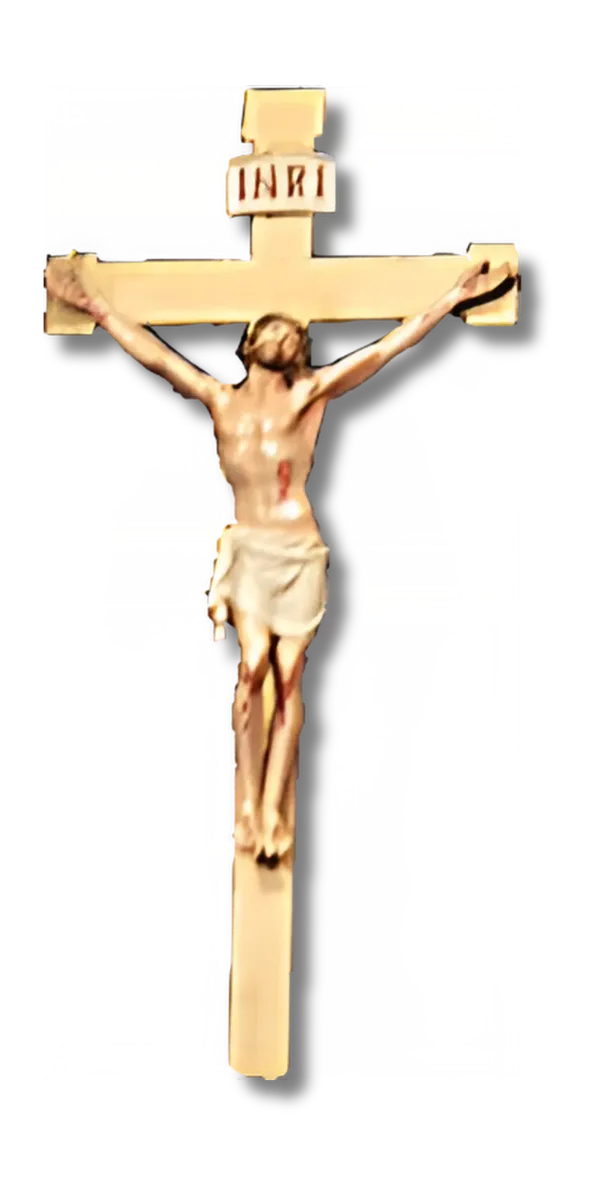
The Crucifix at the Heart: Small in Size, Infinite in Meaning
At the center of the High Altar of St. Mary of the Visitation, flanked reverently by two angels holding wheat and grapes, stands a small crucifix—modest in size, yet immeasurable in spiritual weight. Though it is the smallest statue on the altar, its placement and symbolism speak volumes: here, in quiet humility, is the very heart of our faith—the sacrifice of Jesus Christ for the salvation of the world.
The scale of the crucifix invites a powerful meditation: God's greatest act of love came not through spectacle or grandeur, but through humility, suffering, and self-giving. The crucified Christ, lifted high yet rendered in simplicity, reminds us that the mystery of redemption is not found in outward display, but in the stillness of the cross—where love triumphed through surrender.
The angels on either side, offering symbols of the Eucharist—wheat and grapes—emphasize that the sacrifice of Calvary is not confined to history; it is made present at every Mass. In this way, the crucifix becomes the link between altar and eternity, death and resurrection, suffering and hope.
Though smaller than the surrounding statues of saints and prophets, the crucifix reigns in central position, commanding not with size, but with sacred authority. It reminds us that all the glory of the Church—its saints, teachings, and beauty—flows from this one act of divine mercy: Christ crucified, Christ risen, Christ present in the Eucharist.

The Angel with Grapes: A Symbol of the Eucharistic Sacrifice
To the right of the crucifix on the High Altar of St. Mary of the Visitation, an angelic figure stands in silent adoration, reverently holding a bunch of grapes in its hands. This serene and graceful statue is rich with Eucharistic symbolism, reminding the faithful of the Precious Blood of Christ, poured out in love for the salvation of the world.
The grapes, soon to become wine, are a visual echo of the Last Supper and the sacrifice of the Cross—where wine becomes the Blood of the New Covenant. The angel, a messenger of heaven, presents this offering not as its own, but as a sign of Christ’s gift to the Church: His Body and Blood, truly present in the Eucharist. Its posture—gentle, reverent, and attentive—invites all who gaze upon it to approach the altar with the same devotion.
This statue, paired with its counterpart on the opposite side of the crucifix, frames the mystery of Calvary and Communion, reminding us that what takes place on the altar is a continuation of Christ’s saving work, now made present in the Holy Sacrifice of the Mass.

The Angel with Wheat: A Sign of Christ, the Living Bread
To the left of the crucifix on the High Altar of St. Mary of the Visitation, a second angel stands in quiet reverence, gently holding a sheaf of wheat—a rich and ancient symbol of the Eucharist and Christ’s abiding presence in the Most Blessed Sacrament. With a posture of humility and grace, this angel mirrors its counterpart holding grapes, together representing the essential elements of the Holy Communion: bread and wine.
The wheat recalls the words of Jesus: “I am the living bread that came down from heaven; whoever eats this bread will live forever” (John 6:51). It also evokes the offering of simple gifts from the earth, transformed by grace into the Body of Christ. The angel’s peaceful presence invites the faithful to contemplate the miracle that occurs on the altar at every Mass—where earthly substance becomes heavenly food.
Flanking the crucified Christ, these two angels—one with wheat, the other with grapes—draw our hearts to the Eucharistic mystery, where Christ’s sacrifice on Calvary is made present and His love is offered anew to all who believe.

St. Gregory the Great: Shepherd, Scholar, Servant of the Church
Positioned with quiet majesty upon the High Altar of St. Mary of the Visitation, this statue of St. Gregory the Great honors one of the most influential popes and spiritual leaders in the history of the Church. Clothed in regal robes of purple and green, symbols of penitence and hope, he is depicted holding a crosier, the shepherd’s staff that reflects his pastoral authority and care for souls. Upon his head rests the papal tiara, marking him as Pope Gregory I, who reigned from 590 to 604 A.D.
Unique to this statue is the subtle inclusion of the stigmata, mystical marks that symbolize his deep identification with the suffering of Christ and his own life of self-denial and devotion. In his hands or near him may rest a book or dove, traditional symbols representing his theological brilliance and the Holy Spirit’s inspiration in his writings.
St. Gregory was a reformer, a teacher, and a man of profound humility. He is credited with organizing and standardizing the Church’s liturgy, which gave rise to the tradition of Gregorian chant, and he sent missionaries to evangelize pagan Europe. As one of the four great Doctors of the Western Church, he shaped the Church's understanding of service, leadership, and the mystery of divine worship.
His presence on the High Altar is fitting, for Gregory lived as a true servant of God—leading not with grandeur, but with holiness, wisdom, and a heart devoted entirely to Christ and His Church.
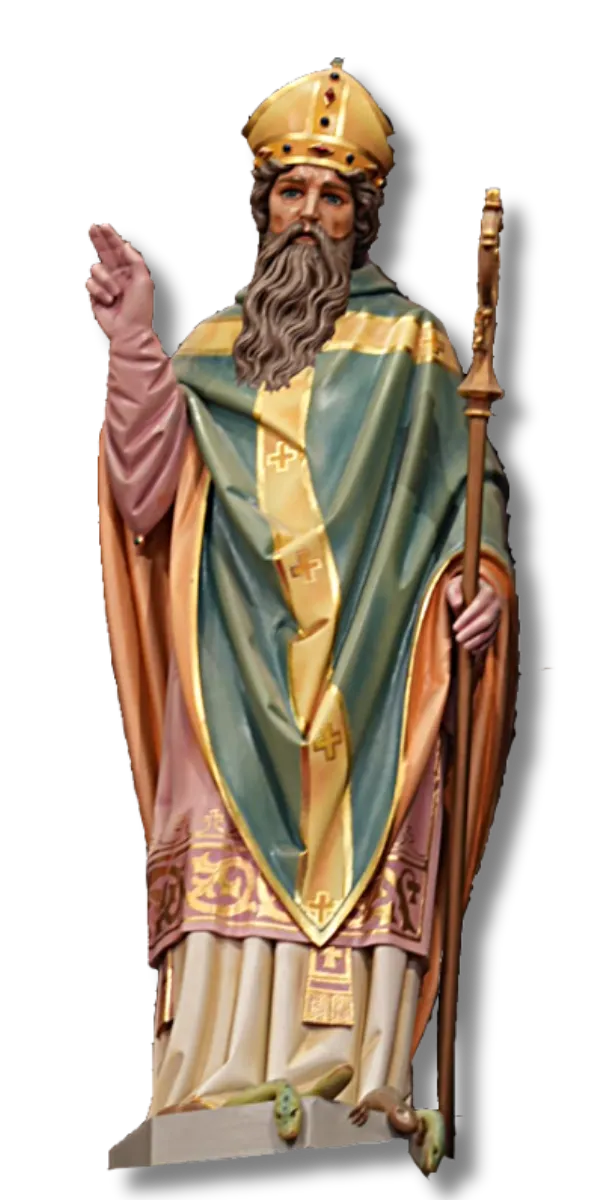
St. Leo the Great: Defender of the Faith, Pillar of the Church
Standing firm upon the High Altar of St. Mary of the Visitation, this commanding statue of St. Leo the Great honors one of the most courageous and theologically gifted popes in Church history. Clothed in green papal robes, a symbol of his pastoral leadership and spiritual renewal, Leo is depicted holding a crosier—the shepherd’s staff—and wearing the papal tiara, signifying his office as the Bishop of Rome and universal pastor of the Church.
Beneath his feet, coiled serpents are crushed, symbolizing his resolute defense of the Church against heresy, evil, and division. This striking imagery reflects both his spiritual authority and his role as a guardian of orthodoxy in a time of great turmoil. St. Leo’s writings—most notably his Tome, which helped define Christological doctrine at the Council of Chalcedon—earned him the title Doctor of the Church.
Leo’s strength was not only theological but pastoral. In one of history’s most dramatic moments, he confronted Attila the Hun face-to-face, persuading him to turn back from invading Rome. The statue thus stands as a visual testament to the power of truth, prayer, and holy leadership in the face of both physical and spiritual threats.
Through this noble image, the faithful are reminded that the Church’s mission is one of truth, protection, and unwavering courage—a legacy lived and safeguarded by St. Leo the Great.
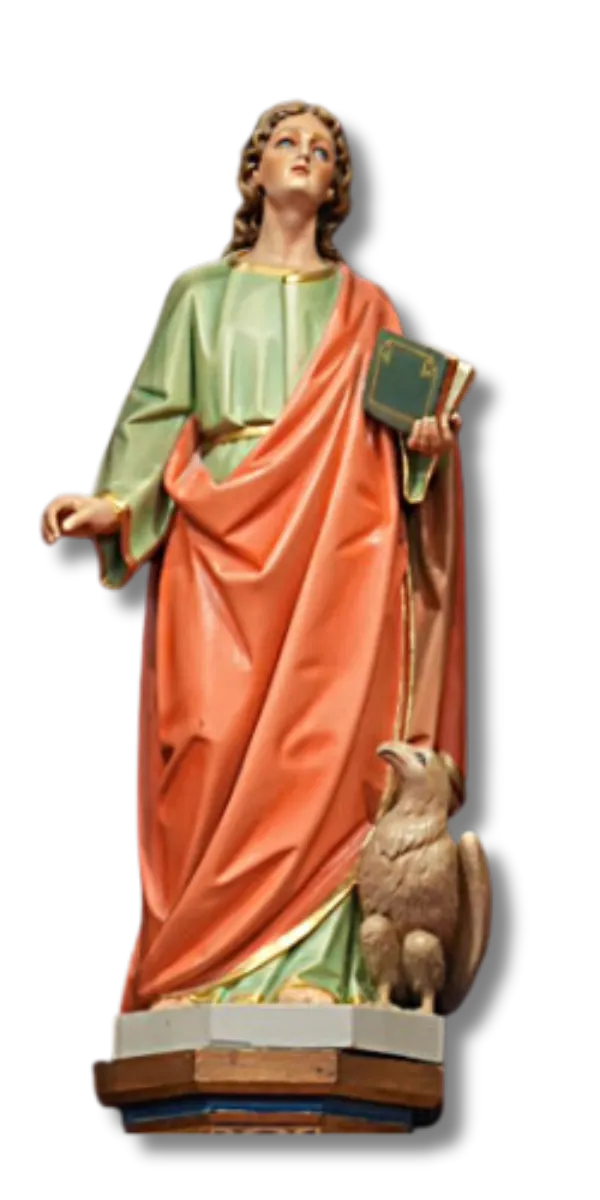
St. John the Evangelist: The Beloved Disciple and Theological Visionary
Located on the right side of the High Altar of St. Mary of the Visitation, this statue of St. John the Evangelist stands as a symbol of spiritual insight, fidelity, and divine revelation. Clothed in green and red robes—signifying hope, martyrdom, and apostolic authority—John is depicted holding a green book, representing the Gospel that bears his name.
At his feet rests an eagle, the traditional symbol associated with St. John. The eagle, known for its ability to soar to great heights and see with piercing clarity, reflects the unique character of John’s Gospel—lofty, poetic, and rich in theological depth. Unlike the Synoptic Gospels, John begins with a profound meditation on the divine nature of Christ: “In the beginning was the Word, and the Word was with God, and the Word was God.”
John is honored as the “beloved disciple,” the one who rested on Christ’s heart at the Last Supper, stood faithfully at the foot of the Cross, and was entrusted by Jesus with the care of His Blessed Mother. His presence on the High Altar—near Mary and the crucified Lord—evokes this sacred relationship and invites the faithful into deeper contemplation of divine love, truth, and communion.
As the final living apostle and the author of the Book of Revelation, John reminds us that our faith is rooted not only in history but in mystery—forever echoing the promise of eternal life through Christ, the Word made flesh.
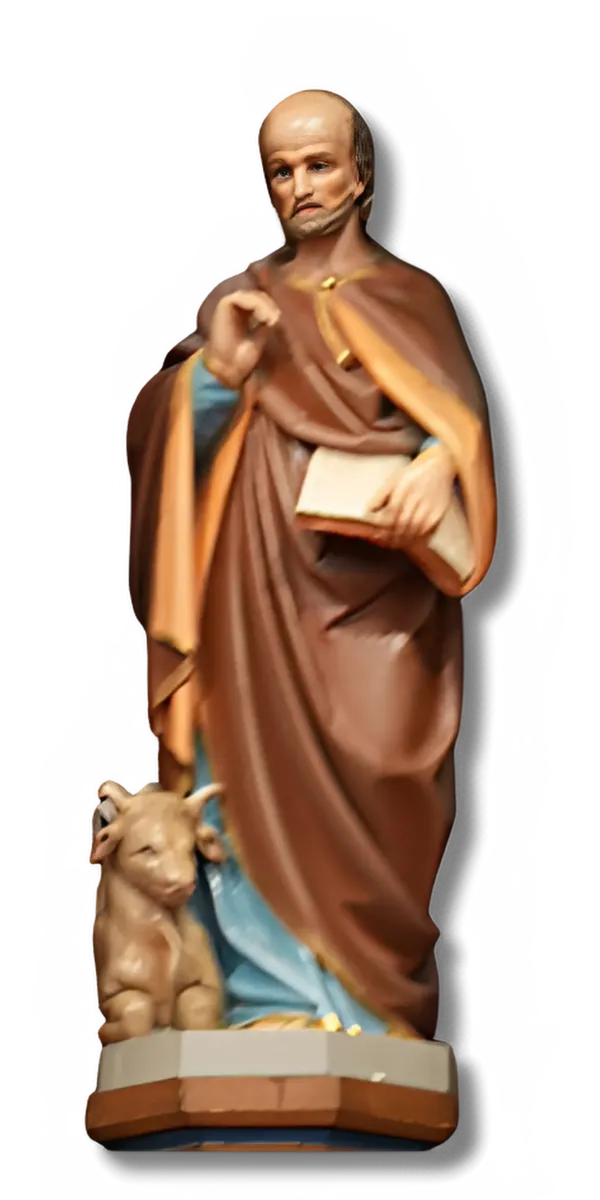
St. Luke the Evangelist: Herald of Mercy and the Humanity of Christ
Positioned beside St. John the Evangelist on the High Altar of St. Mary of the Visitation, this statue of St. Luke the Evangelist invites the faithful to contemplate the depth of God’s mercy and the sacred dignity of Christ’s incarnation. Clothed in humble brown robes, Luke is portrayed as a thoughtful and steady presence—grounded in his identity as both physician and historian, and guided by divine inspiration.
At his feet lies the figure of a calf or ox, the traditional symbol of St. Luke. This image, drawn from the prophetic visions of Ezekiel and the Book of Revelation, represents sacrifice, service, and priestly devotion—key themes in Luke’s Gospel. It reminds us that Jesus came not only as teacher and healer, but as the Lamb of God who takes away the sins of the world.
Luke’s Gospel is unique in its attention to the poor, the outcast, and the role of women in salvation history. He alone records the Visitation, the Magnificat, and the tender details of Christ’s birth—making his presence on this altar dedicated to Mary’s Visitation especially fitting. His writings also include the Acts of the Apostles, chronicling the birth and mission of the early Church.
This statue honors St. Luke not only as a writer of sacred history, but as a witness to Christ’s compassion and a messenger of hope. Through his eyes, we see a Savior who enters fully into our humanity—and through his words, we are invited to encounter the healing mercy of God.
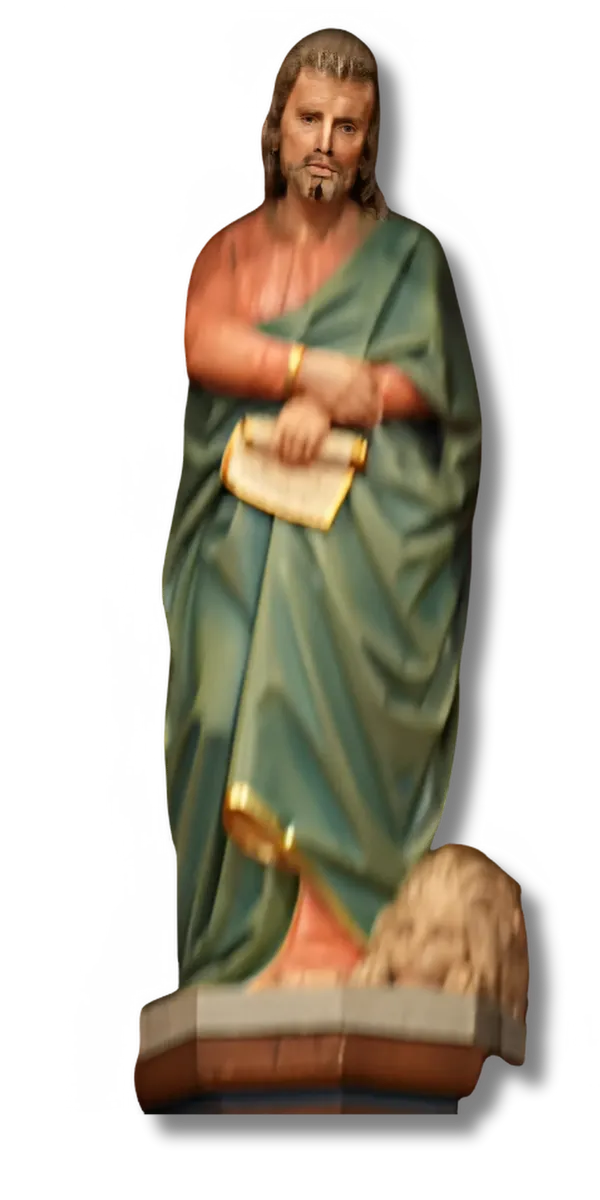
St. Mark the Evangelist: Bold Herald of the Good News
Standing on the left side of the High Altar of St. Mary of the Visitation, the statue of St. Mark the Evangelist radiates strength, clarity, and apostolic fervor. Clothed in rich red and green robes, Mark holds a scroll, symbolizing the Gospel that bears his name—believed to be the earliest written account of the life of Jesus. At his feet rests a lion, the traditional symbol of St. Mark, evoking both the majesty of Christ the King and the courage of the Gospel message.
The lion, drawn from the visions in Ezekiel and Revelation, represents the voice crying out in the wilderness, a reference to the opening of Mark’s Gospel and the mission of John the Baptist. It also speaks to the power and authority with which St. Mark proclaims Christ as the Son of God, whose miracles, teachings, and Passion reveal both divine power and profound humility.
St. Mark’s Gospel is fast-paced and vivid, emphasizing action and immediacy. It invites readers to follow Christ not merely through knowledge, but through discipleship and service. As a companion of St. Peter, Mark’s Gospel reflects the teachings of the first pope and preserves the foundational witness of the early Church.
His presence on the High Altar—alongside the other evangelists and the crucified Christ—reminds the faithful that the Gospel is alive and active, and that we, too, are called to proclaim the Good News with courage, conviction, and joy.
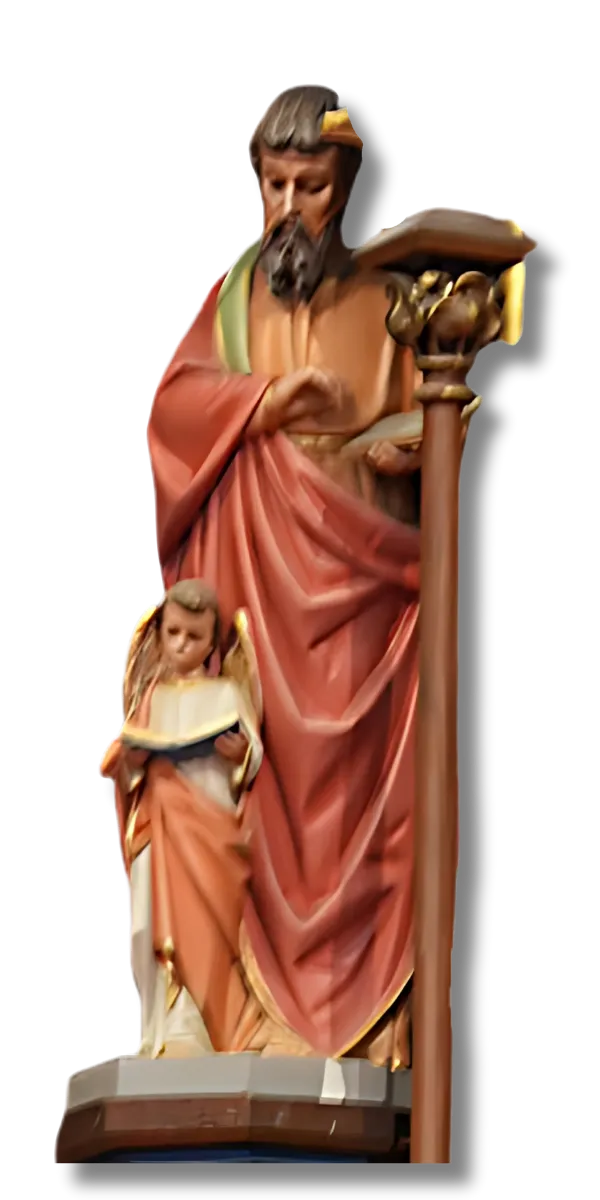
St. Matthew the Evangelist: Witness to the Incarnate Word
Positioned beside St. Mark on the High Altar of St. Mary of the Visitation, the statue of St. Matthew the Evangelist offers a contemplative image of divine inspiration and faithful authorship. Clothed in apostolic robes and captured in a moment of stillness, Matthew is shown gazing downward at a young angel seated at his side, who is attentively reading from a sacred book.
The angel, or winged man, is the traditional symbol of St. Matthew, drawn from the prophetic imagery of Ezekiel and Revelation. It signifies the humanity of Christ—a central theme in Matthew’s Gospel, which begins with the genealogy of Jesus, tracing His earthly lineage as the Son of David and the fulfillment of God’s promises to Israel.
As a former tax collector called by Jesus to a life of discipleship, Matthew’s own transformation mirrors the message of his Gospel: that God's mercy extends to all, and that Christ came not to abolish the Law, but to fulfill it. His writings emphasize Jesus as teacher, Messiah, and Emmanuel—God with us.
This statue, with its posture of attentiveness and spiritual guidance, reminds the faithful that the Gospels are not merely historical accounts, but living words born of divine inspiration and human faithfulness. St. Matthew’s presence on the High Altar affirms the Church’s foundation on the witness of the apostles and invites all believers to encounter Christ anew through the Word.
Side Altar of St. Joseph
Located on the Right Side of the Parish
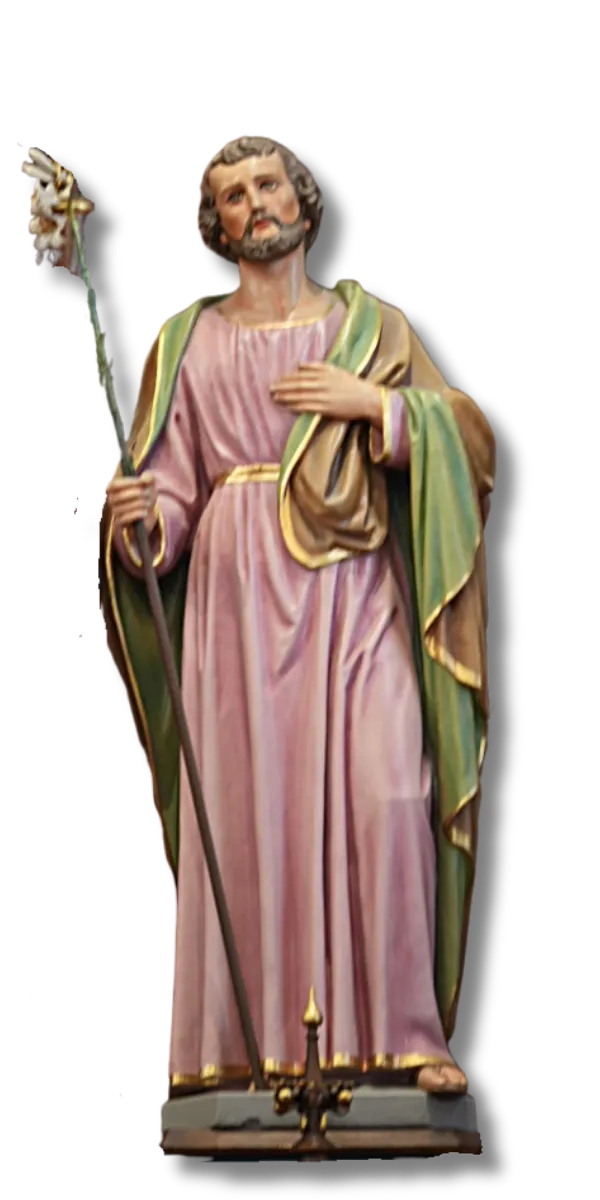
St. Joseph and the Lily: A Symbol of Purity, Strength, and Silent Devotion
Throughout the centuries, Christian artists have portrayed St. Joseph—the earthly father of Jesus and spouse of the Blessed Virgin Mary—with various attributes that reflect his unique role in salvation history. Among these, one of the most enduring and powerful symbols is the lily. When we encounter a statue of St. Joseph holding a lily, we are invited into a deeper reflection on his virtue, his mission, and his place within the Holy Family.
Historically, the lily represents purity and righteousness, qualities that define Joseph’s life and his quiet strength in following God’s will. According to apocryphal tradition, the flowering of Joseph’s staff was the miraculous sign by which he was chosen as the spouse of Mary. This blossoming rod, often depicted as a lily, is a symbol of divine selection and purity—a visual echo of his chaste guardianship over the Virgin and his obedient care for Jesus.
In Christian devotion, the lily also speaks to St. Joseph’s spiritual authority. Though he left no recorded words in Scripture, his actions spoke volumes—offering protection, guidance, and sacrificial love without acclaim or recognition. Statues of St. Joseph with the lily remind us that true holiness is often quiet, steadfast, and humble. He is the patron of workers, fathers, and the universal Church, standing as a model of integrity and trust in God’s plan.
This particular image of St. Joseph within St. Mary of the Visitation is more than art—it is a visual invitation to follow his example: to live with courage, purity, and unwavering faith in the face of uncertainty.
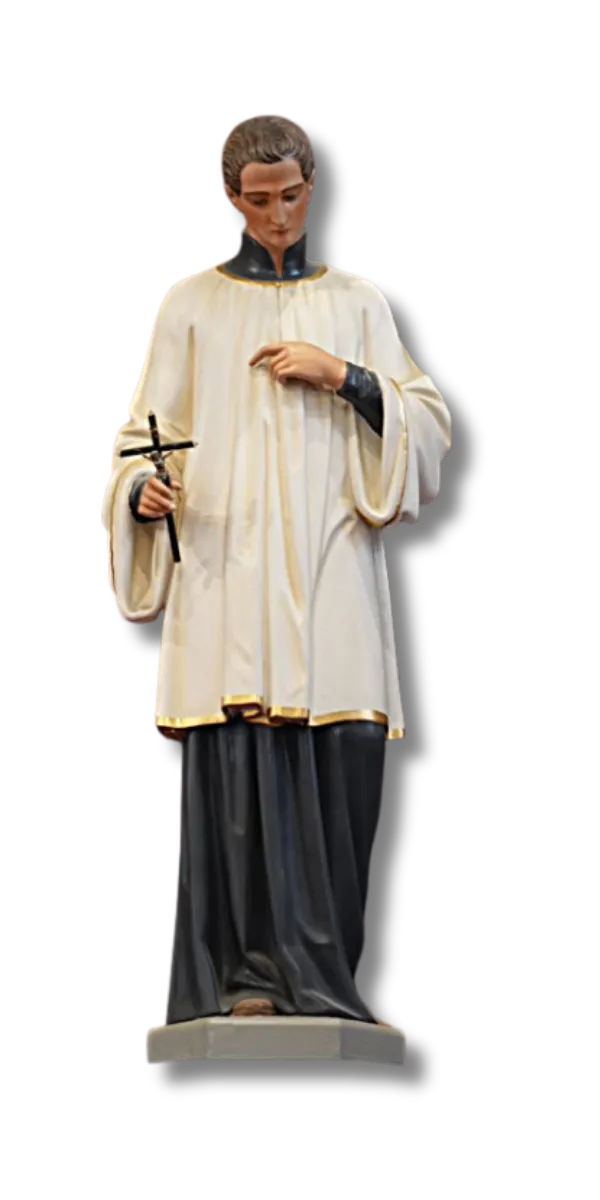
St. Tarcisius: Young Martyr of the Eucharist
This statue of St. Tarcisius, often portrayed as a youthful altar server clutching a cross or holding the Eucharist close to his chest, commemorates one of the early Church’s youngest and most courageous martyrs. Living during the third century, in a time when Christians faced severe persecution under the Roman Empire, Tarcisius was entrusted with the sacred duty of delivering the Blessed Sacrament to imprisoned Christians awaiting martyrdom.
Tradition tells us that on one such mission, Tarcisius encountered a group of Roman youths who demanded to see what he was carrying. Aware of the holy presence he bore, the boy refused to surrender the Eucharist. In his fierce loyalty to Christ, he endured a brutal attack and died from his injuries—protecting the consecrated Hosts to his last breath.
Though little is known about him historically, the story of Tarcisius was later popularized by the writings of Pope Damasus and remains a powerful testimony to Eucharistic devotion. His statue, typically dressed in the humble vesture of an altar server, stands as a reminder that sanctity is not reserved for the aged or powerful—it is accessible to the young, the faithful, and the brave.
Declared the Patron Saint of Altar Servers, St. Tarcisius challenges each of us—especially the youth—to approach the altar of God with reverence, courage, and a heart ablaze with love for the Real Presence of Christ in the Eucharist.
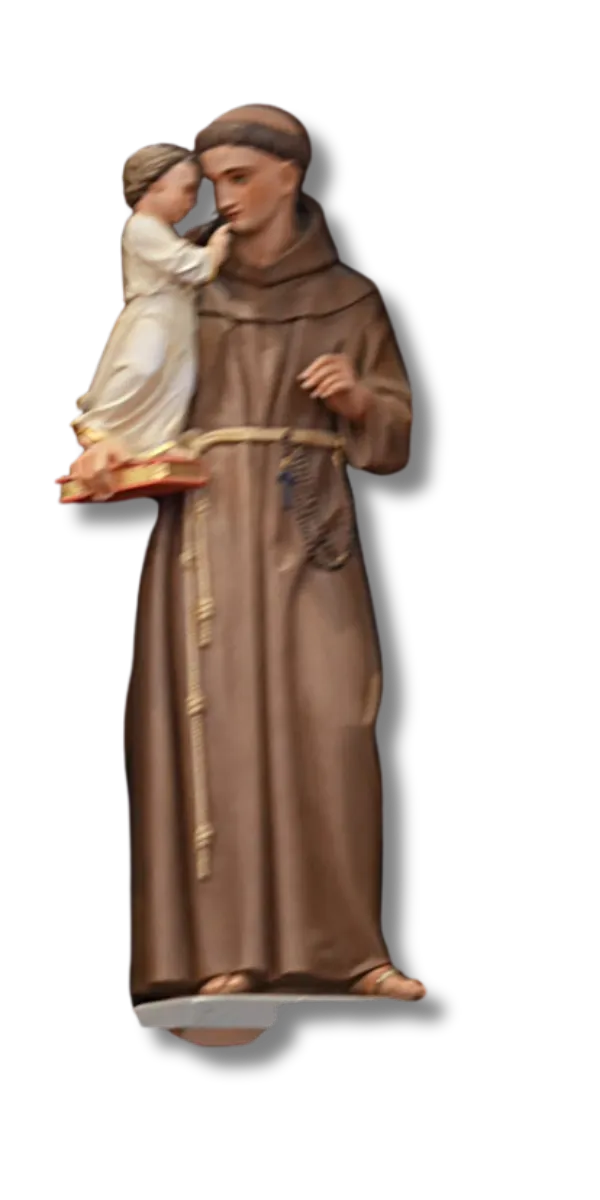
St. Anthony of Padua: Preacher of the Word, Friend of the Christ Child
This statue of St. Anthony of Padua, clothed in the simple brown habit of a Franciscan friar, captures one of the most tender and beloved moments in Catholic devotion. Here, we see St. Anthony cradling the Child Jesus, who stands or rests upon the Sacred Scriptures, symbolizing the saint’s profound knowledge of God’s Word and his deep love for Christ made flesh.
Born in Lisbon, Portugal, in 1195, and later joining the Franciscan Order, St. Anthony became known throughout Europe for his powerful preaching, his deep humility, and his miracles. He was a fearless teacher of truth and a gentle servant to the poor. Tradition holds that during a time of prayer and contemplation, Anthony was granted a mystical vision of the infant Jesus, who appeared to him and rested in his arms—a moment beautifully portrayed in sacred art and sculpture.
The book beneath the Christ Child reminds us of Anthony’s unmatched command of Scripture and his title as a Doctor of the Church. The lily, often seen in his hand or near his feet, is a symbol of his purity and sanctity.
St. Anthony is widely venerated as the patron saint of lost things, but he is much more than a heavenly helper in times of forgetfulness. His life and image invite us to pursue truth, to love the poor, and to draw closer to Christ through prayer, study, and selfless service.
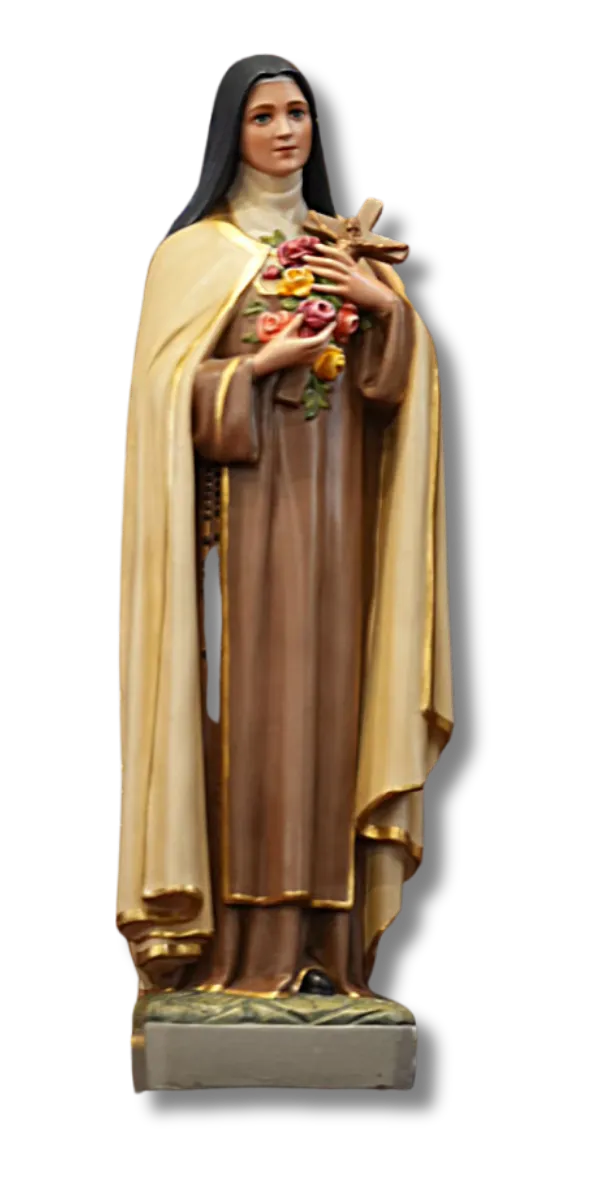
St. Thérèse of Lisieux: The Little Flower of Jesus
This statue of St. Thérèse of Lisieux, also known as “The Little Flower,” depicts one of the most cherished saints of the modern Church. Clothed in the traditional brown and white habit of the Carmelite Order, with a dark veil and a serene expression, Thérèse is shown holding a crucifix close to her heart—surrounded by or carrying an abundance of roses in various colors.
Born in France in 1873, Thérèse entered the Carmelite convent in Lisieux at the age of 15 and lived a hidden life of prayer, humility, and love. Her “Little Way”—doing ordinary things with extraordinary love—has inspired millions to seek holiness in the simple, everyday moments of life. Though she died at just 24 years old, her spiritual autobiography, Story of a Soul, became a worldwide bestseller and continues to touch hearts across generations.
The roses in this statue reflect her famous promise: “After my death, I will let fall a shower of roses. I will spend my heaven doing good on earth.” The crucifix represents her deep love for Christ and her willingness to unite her daily sufferings to His.
Declared a Doctor of the Church in 1997, St. Thérèse reminds us that greatness in God’s eyes is not measured by grand achievements, but by the depth of our love and the humility of our hearts.
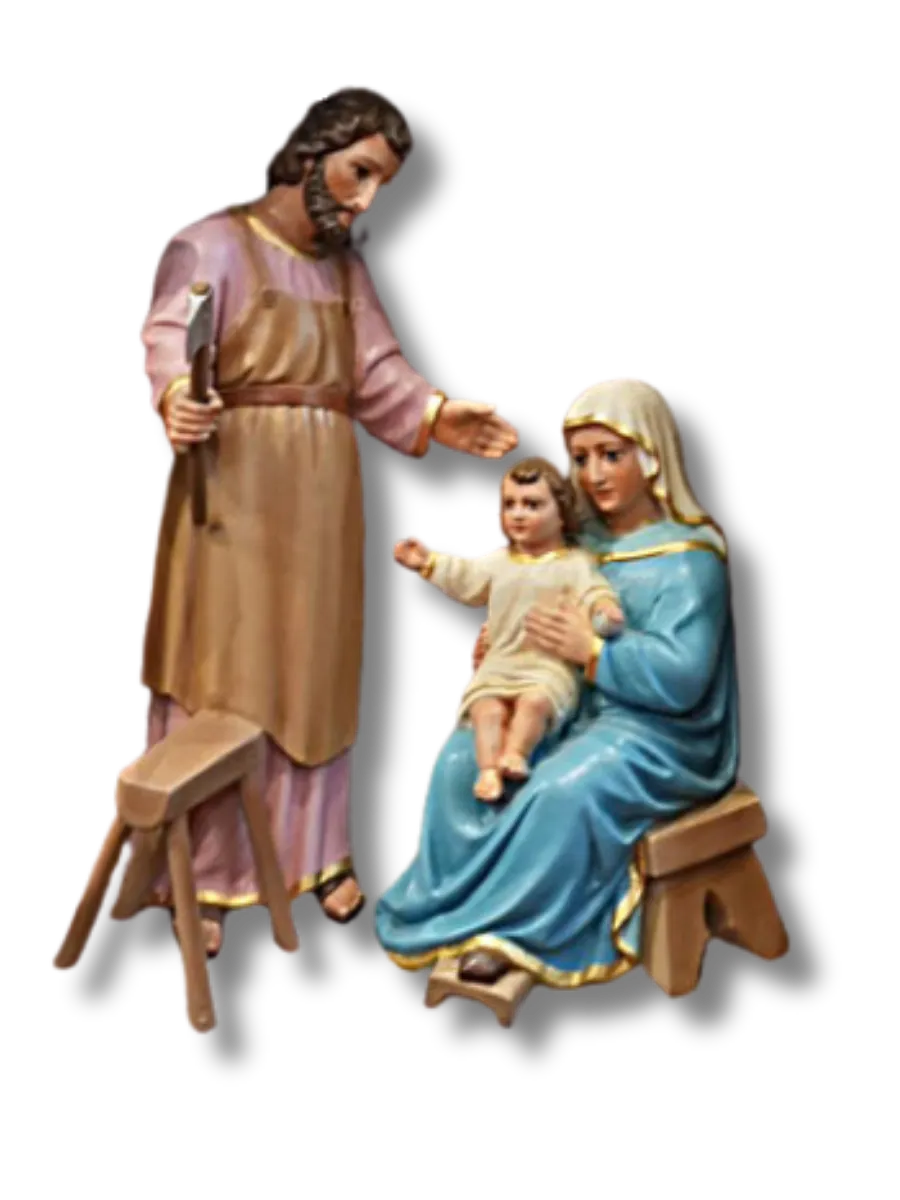
The Holy Family: A Portrait of Love, Labor, and Divine Grace
This beautifully crafted statue of the Holy Family offers a glimpse into the hidden life of Jesus, Mary, and Joseph—centered in the quiet sanctity of home and daily labor. In this depiction, St. Joseph stands watchfully, holding an axe over a wooden workbench, a symbol of his vocation as a carpenter and provider. His posture reflects strength, dedication, and the dignity of honest labor, reminding us that work, when done with love, becomes a path to holiness.
Seated nearby is the Blessed Virgin Mary, dressed in flowing shades of heavenly blue, a traditional symbol of purity, motherhood, and devotion. She tenderly cradles the infant Jesus in her arms, embodying the serenity and grace of the Mother of God. Her gentle gaze and the peaceful expression of the Christ Child remind us that even in the humblest of settings, the divine presence can dwell.
This statue invites the faithful to reflect on the virtues of family life—faith, humility, sacrifice, and unity—as modeled by the Holy Family of Nazareth. In their quiet strength and mutual love, they offer a timeless example of what it means to live in God's will, even in the ordinary rhythm of daily life.
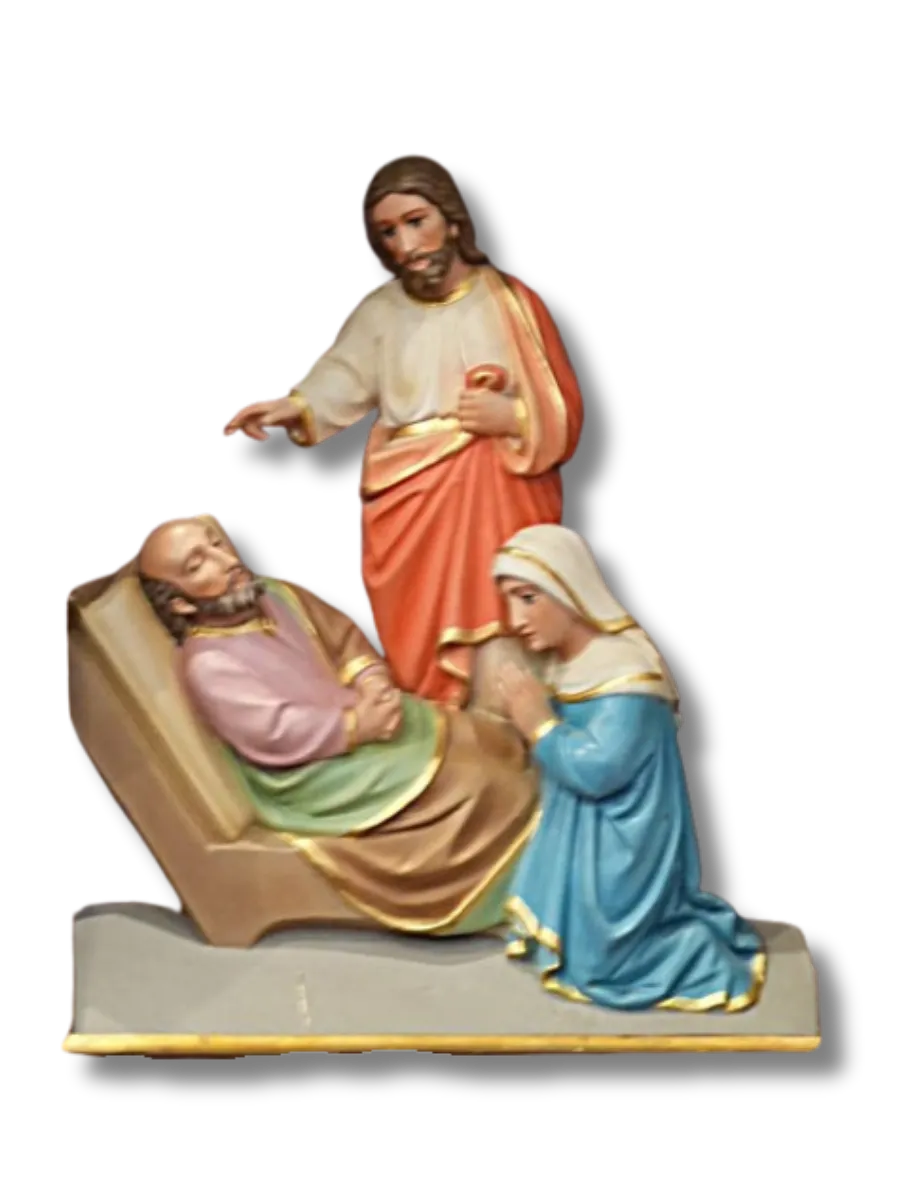
The Death of St. Joseph: A Peaceful Passing
in the Presence of Jesus and Mary
This poignant statue captures one of the most tender and sacred moments in Christian tradition: the happy and holy death of St. Joseph. In this depiction, St. Joseph lies on his deathbed, his face peaceful and his hands gently folded or resting. Beside him stands his foster son, Jesus—now a grown man—raising His hand in blessing, offering comfort and divine peace to the man who faithfully raised Him.
Kneeling nearby is the Blessed Virgin Mary, her hands clasped in prayer, her gaze fixed with love and sorrow. Her posture reflects both her grief and her unwavering trust in God’s plan. Clothed in soft tones of blue and white, she represents the steadfast heart of the Holy Family—present, praying, and loving to the very end.
This statue is more than a scene of earthly farewell; it is a testament to the dignity of a holy death, surrounded by those we love, anchored in faith. St. Joseph, the patron of a happy death, is shown passing from this world in the presence of Jesus and Mary, a grace all Christians are invited to hope for. The scene encourages reflection on the beauty of a life lived in quiet service, and the reward of being welcomed into eternal peace by the Savior Himself.
Side Altar of St. Mary
Located on the Left Side of the Parish
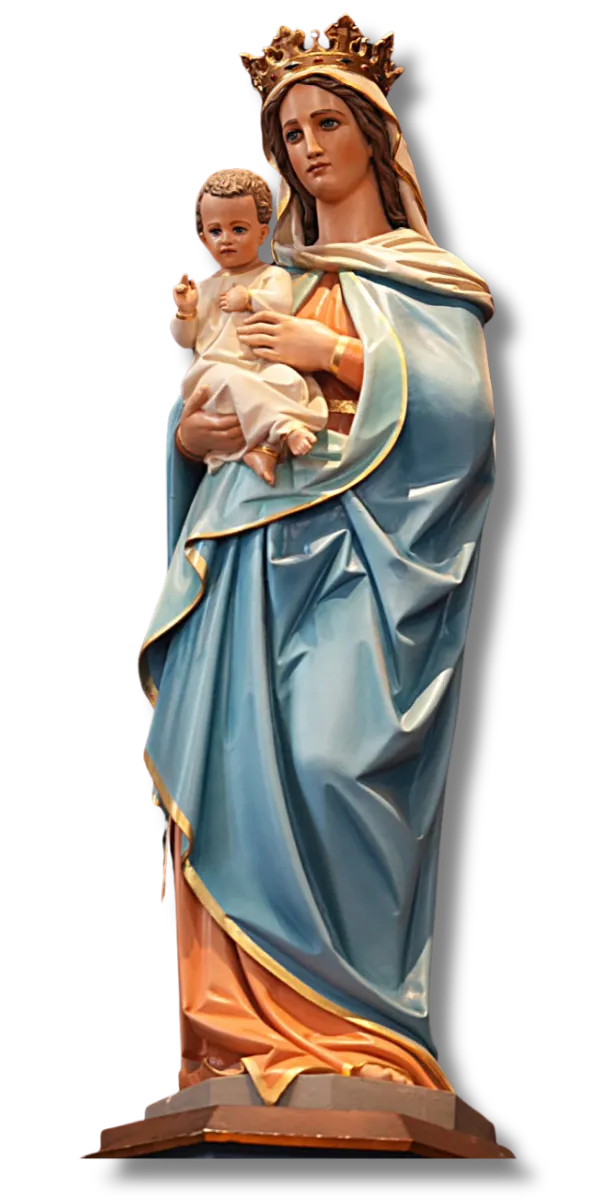
Our Lady and the Christ Child: Love and Grace at the Heart of the Altar
At the top and center of the Side Altar of St. Mary, this statue of the Blessed Virgin Mary holding the Child Jesus draws the faithful into a quiet moment of maternal love and divine presence. Mary stands with calm dignity, clothed in flowing robes—traditionally blue and white—symbolizing her purity and heavenly role. Her expression is peaceful and inviting, her gaze gently directed toward those in prayer.
In her arms, the infant Jesus is clothed in simple white garments, a sign of His innocence and holiness. With arms often outstretched or raised in blessing, He is presented not as a distant ruler, but as the approachable Savior—fully divine, yet fully human. The simplicity of the image emphasizes the humility of the Incarnation and the intimate bond between Mother and Son.
This statue reminds us that Mary, as the first disciple and Mother of God, continues to lovingly present her Son to the world—inviting us to draw near with trust, devotion, and joy.
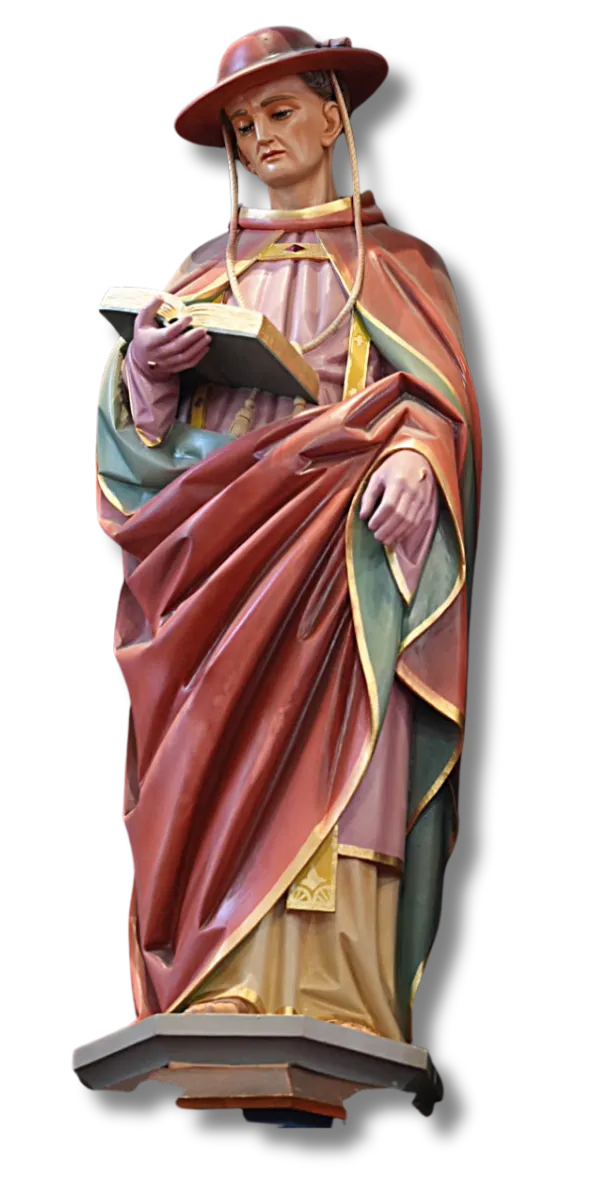
St. Bonaventure: The Seraphic Doctor of the Church
On the upper right side of the Side Altar of St. Mary, this statue of St. Bonaventure honors one of the Church’s greatest theologians and mystics. Clothed in the red robes and biretta of a cardinal, St. Bonaventure is depicted in a moment of deep contemplation, his gaze fixed on the open book in his hands, symbolizing his profound contributions to sacred theology and Franciscan spirituality.
A devoted follower of St. Francis of Assisi, Bonaventure became known as the “Seraphic Doctor” for his blend of intellectual brilliance and burning love for Christ. The presence of the stigmata, subtly visible, reflects not only his veneration of St. Francis but also his intimate spiritual union with the suffering Christ—a mark more symbolic than historical, pointing to his deep interior life.
This statue invites the faithful to reflect on the harmony between faith and reason, prayer and study, love and knowledge. As a Doctor of the Church, St. Bonaventure reminds us that the path to holiness is one that engages both the heart and the mind, always directed toward the glory of God.
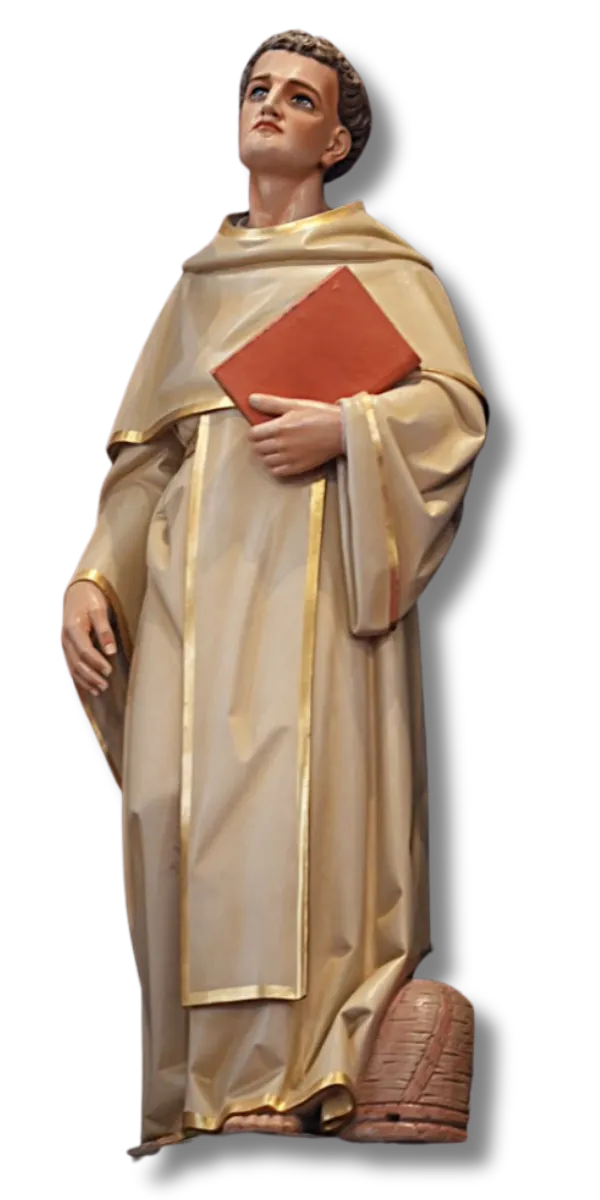
St. Ambrose: Voice of Wisdom, Defender of the Faith
On the upper left side of the Side Altar of St. Mary, the statue of St. Ambrose of Milan presents a striking image of youthful dignity and spiritual intellect. Clothed in white episcopal robes, St. Ambrose is depicted holding a red book, symbolizing his powerful sermons, theological writings, and unwavering defense of Church doctrine. At his feet rests a beehive, an enduring symbol of his eloquence, wisdom, and the sweet harmony of truth proclaimed in love.
According to tradition, a swarm of bees once landed on the infant Ambrose’s face as he lay in his cradle, leaving behind a drop of honey. This was seen as a divine sign that his words would one day flow with the richness and sweetness of the Gospel. As a 4th-century bishop of Milan, Ambrose became one of the most influential voices in the early Church, helping to shape Christian theology and famously guiding the conversion of St. Augustine.
This statue invites the faithful to consider the power of words formed by faith and intellect. St. Ambrose, one of the original Doctors of the Church, remains a patron of beekeepers, learners, and those who strive to speak truth with clarity and charity.
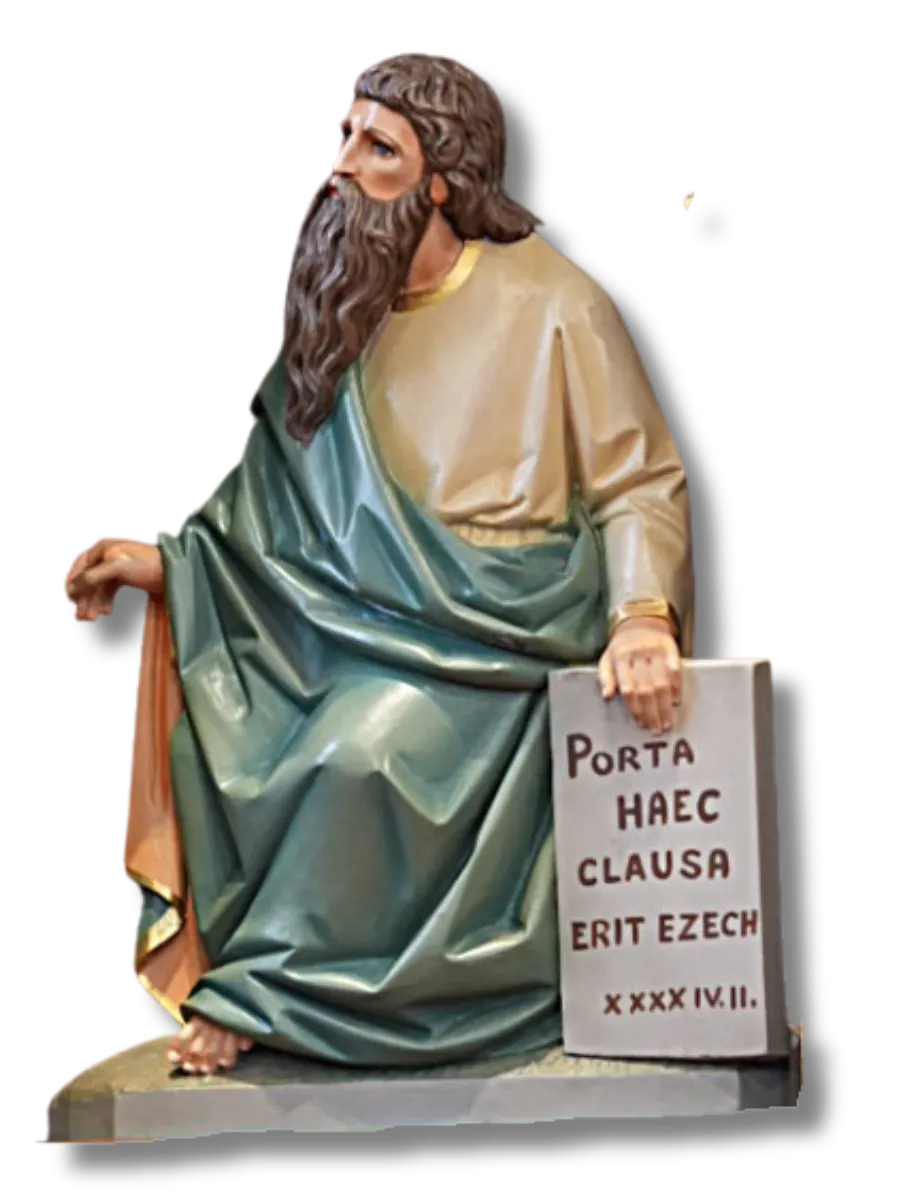
The Prophet Ezekiel: Foreteller of the Virgin Gate
Located near the Side Altar of St. Mary, this statue of the Prophet Ezekiel honors one of the most profound visionaries of the Old Testament. Seated in quiet contemplation, Ezekiel is depicted as an older, bearded man, clothed in flowing robes, and holding a stone tablet inscribed with the words: “Porta haec clausa erit – Ezech” (“This gate shall remain shut – Ezekiel”).
This phrase is drawn from Ezekiel 44:2, a prophetic passage that the Church has long understood as a foreshadowing of the perpetual virginity of Mary. The "closed gate" represents the womb of the Blessed Virgin, through which Christ entered the world, yet which remained untouched—preserved in her singular holiness.
Ezekiel's upward gaze toward the statue of Mary and the Christ Child above reflects his role as a prophet who looked forward to the coming of the Messiah. His presence at the altar reminds the faithful that God’s plan of salvation unfolds across generations, and that Mary, the "Gate of Heaven," is the fulfillment of ancient prophecy.
This statue calls us to contemplate the mystery of the Incarnation and the ways in which the Old Testament prophets prepared the way for the coming of Christ—each one pointing toward the woman who would bear Him into the world.
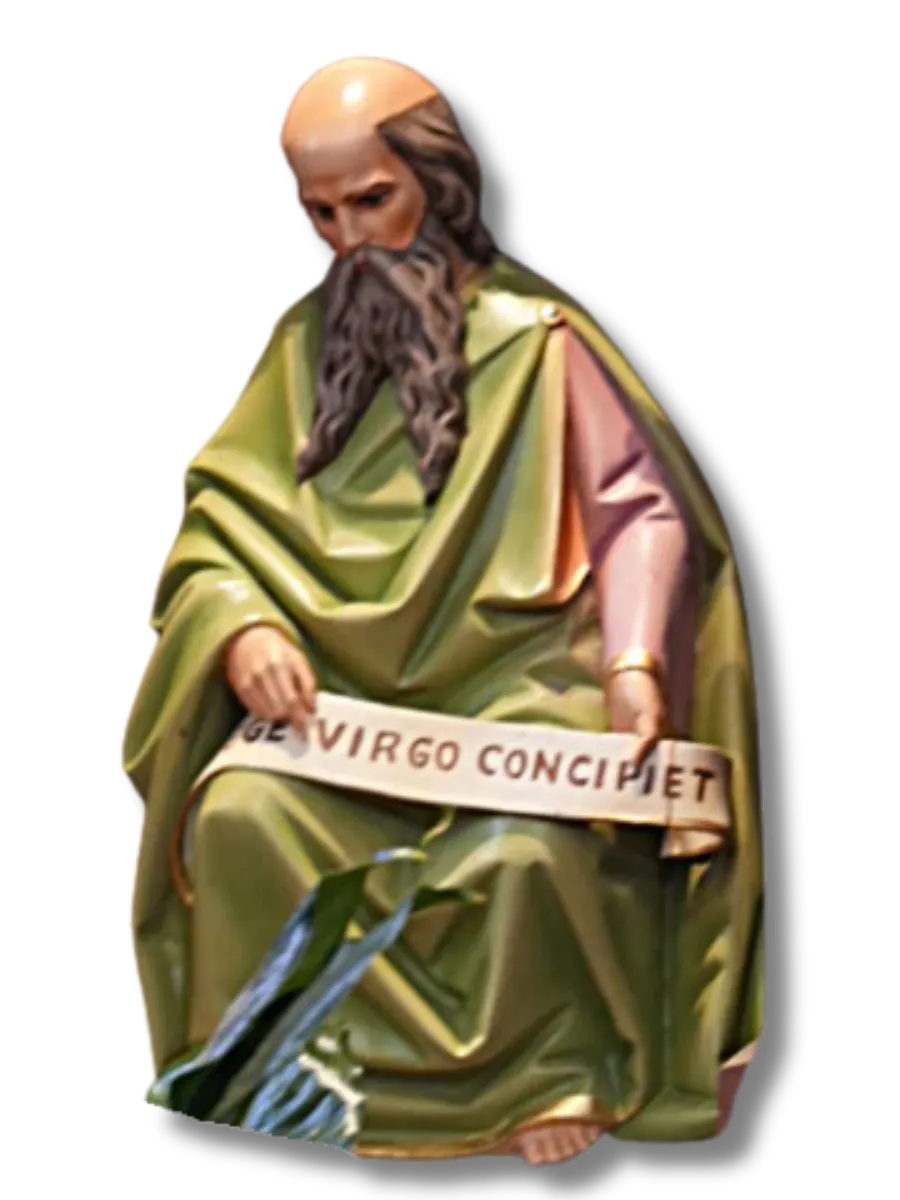
The Prophet Isaiah: Herald of the Virgin Birth
This statue of the Prophet Isaiah, located near the Side Altar of St. Mary, portrays one of the most revered voices of the Old Testament. Seated in thoughtful repose, Isaiah is depicted as an older man with a flowing beard, dressed in stately robes. In his hands, he holds an unrolled scroll bearing the prophetic words: “Virgo concipiet”—Latin for “A virgin shall conceive”—a reference to Isaiah 7:14, one of the most well-known and theologically rich prophecies concerning the coming of the Messiah.
This verse is cherished by the Church as a direct foretelling of the virginal conception of Jesus Christ and the unique role of the Blessed Virgin Mary in salvation history. By including Isaiah near the altar dedicated to Mary, the Church draws a powerful visual connection between Old Testament prophecy and New Testament fulfillment.
Isaiah’s presence invites us to recognize how the longings and promises of Israel are realized in Mary’s “yes” and in the birth of Christ. He stands as a witness across the centuries, proclaiming the mystery of the Incarnation with clarity and hope.
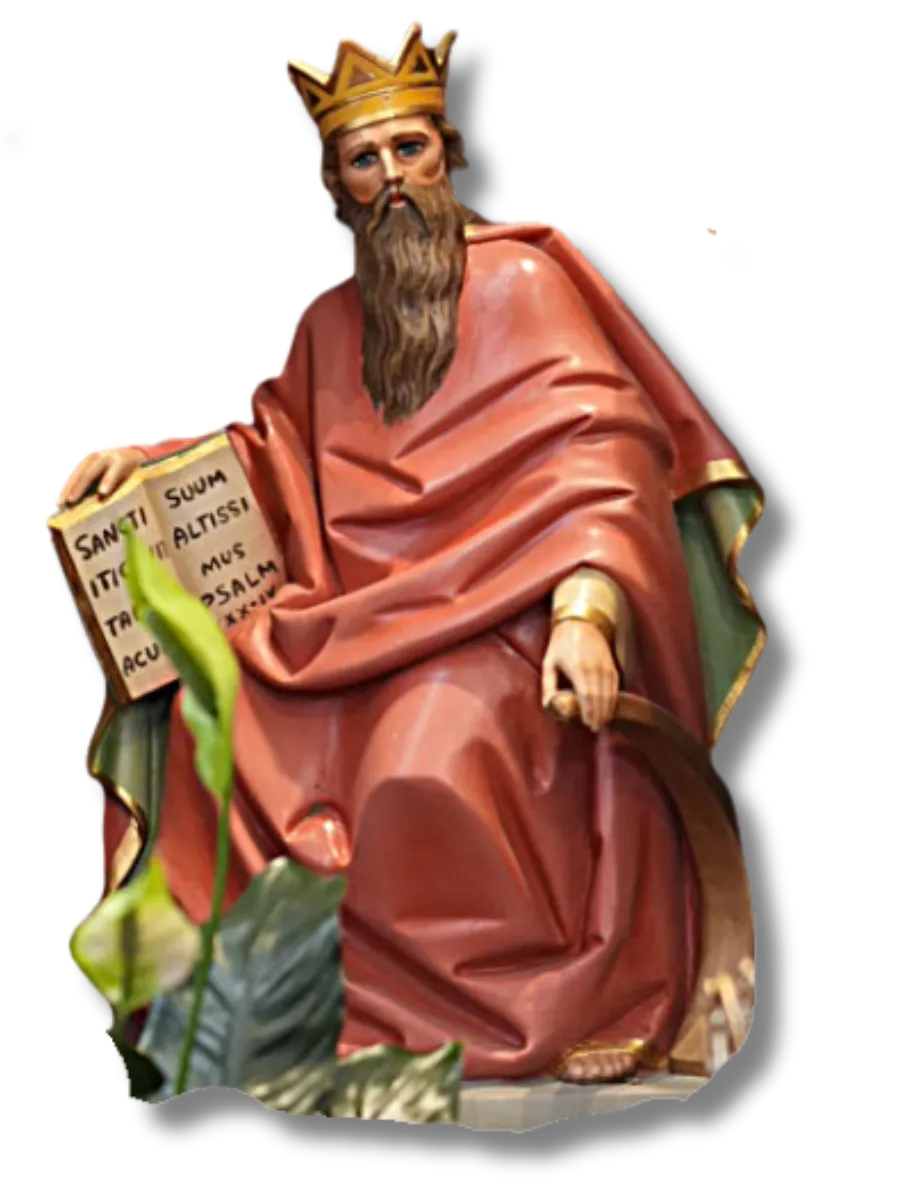
King David: Royal Ancestor and Psalmist of the Lord
Positioned prominently on the Side Altar of St. Mary, this statue of King David stands crowned and clothed in rich red robes, symbolizing his royal lineage and enduring role in salvation history. He holds an open book, inscribed with the Latin phrase “Sancti suum...”, likely drawn from the Psalms—expressing God's faithfulness to His holy ones. The book represents the Book of Psalms, many of which are traditionally attributed to David, and which have formed the spiritual heart of Jewish and Christian prayer for centuries.
As the shepherd-king of Israel, David is revered not only for his leadership but also for his poetic and prophetic voice, which foretold the coming of the Messiah. His inclusion on this Marian altar is deeply symbolic: David is the earthly forefather of Jesus, and the promises made to him are fulfilled in Christ, born of the Virgin Mary.
This statue invites the faithful to reflect on God’s covenantal faithfulness and the role of praise in the spiritual life. Through David’s inspired words, sung in churches and monasteries across the world, the Church continues to lift her voice in worship—awaiting, as David did, the fullness of God’s promise, now revealed in Christ.
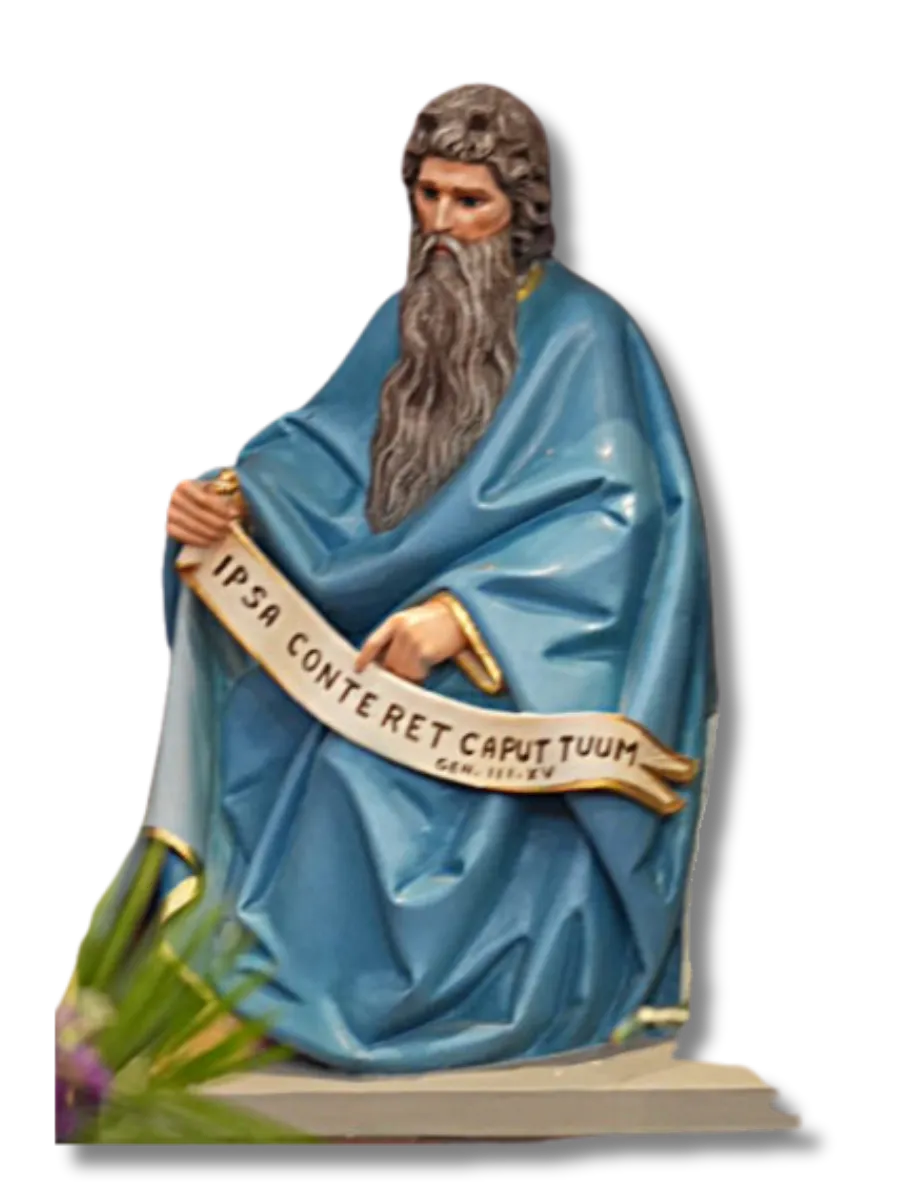
The Prophet Moses: Bearer of the Law, Foreshadower of Salvation
Seated in solemn contemplation on the Side Altar of St. Mary, this statue of Moses honors the great lawgiver and prophet of the Old Testament. Clothed in flowing blue robes, symbolizing divine wisdom and his intimate relationship with God, Moses holds a scroll inscribed with the Latin words “Ipsa conteret caput tuum”—“She shall crush your head.” This verse, drawn from the Book of Genesis (3:15), is often called the Protoevangelium, or “First Gospel,” as it is the first promise of a Redeemer to come—a Redeemer who would be born of a woman and defeat evil.
Though Moses lived long before the fulfillment of this prophecy, he is traditionally credited as the inspired author of Genesis. His presence on this Marian altar serves as a profound reminder that the Law he received on Mount Sinai was only the beginning of God's greater plan—a plan fulfilled in Jesus Christ, born of the Blessed Virgin Mary, the woman foretold in Genesis.
The statue’s posture and inscription draw the viewer into a deeper appreciation of how Old Testament revelation points toward New Testament fulfillment. Moses, the great mediator between God and His people, now bears witness to the new and everlasting covenant, brought to completion in Mary’s “yes” and the birth of the Savior.
Thank you for visiting.
We are continually updating this online guide
with other images and their significance within our parish.
